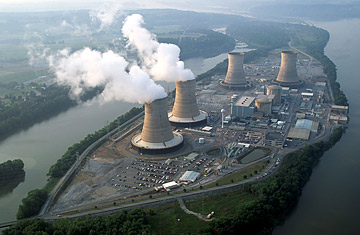
Three Mile Island Nuclear Power Plant
(3 of 11)
Whatever the final report, months from now, on what went wrong and how at Three Mile Island, the way in which federal and plant officials seemed to handle the breakdown will not help the industry's image. The trouble was dismissed at first by Jack Herbein, Metropolitan Edison's vice president for power generation, in a memorable engineer's euphemism, as merely "a normal aberration." Reassuring statements spewed from the plant's press spokesmen, sounding as if they were taken right out of the script for the film The China Syndrome, a thriller that depicts nuclear plant officials as placing greed for profits far above their concern for public safety. But if the movie, starring real-life Antinuclear Activist Jane Fonda, is unfair in its villainous caricature of power-and construction-industry officials, its basic premise will no longer seem so farfetched to those moviegoers until now unattuned to the nation's debate over nuclear power. The premise: that a nuclear power plant is not nearly as accident-proof as its builders proclaim and that "the China Syndrome," a total meltdown that causes the core to sink lethally into the earth (hence, fancifully, toward China), is not a totally outlandish possibility. Ironically, though the film's fictional plant is located in California, the example that is offered of the devastation a meltdown could cause is an area the size of Pennsylvania. Even more ironically, given the bias of the film makers, what actually happened at Three Mile Island is far more serious than the "event" portrayed at the fictional plant.
The stock market indicated the public's response. Shares of Columbia Pictures, which gained a publicity bonanza for its movie, soared by $2.74 in two days, to $24.75. Stocks of nuclear power companies declined sharply. General Public Utilities, which owns the damaged plant, dropped 50¢ a share, while the stock of Kerr-McGee plunged $4.12, to $51.
When the first alarm sounded inside Unit 2 at 4 a.m. on Wednesday, only about 60 employees were at work. Precisely what the engineers at the control panels did to find out why the turbine had tripped—and just what steps they took next—will be the object of long investigations. Company spokesmen insisted that most of the procedures had been automatic, implying that all of the complex machinery, with its multiple, supposedly infallible back-up systems, had flipped into computer-controlled action.
Don Curry, Metropolitan Edison's top public relations man, explained initially that a pump had broken down in the reactor's secondary loop, which carries nonradioactive water into the steam generator, where it absorbs heat that is transferred from the nuclear chain reaction in the core by the primary loop, turns to steam and drives the turbine that generates electricity. Lacking the steam's push, the turbine automatically shut down. This, said Curry, was regarded by the engineers as a routine mechanical failure that under the plant's safety rules did not have to be immediately reported to state or federal authorities.
